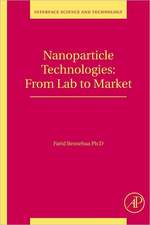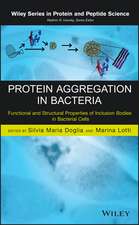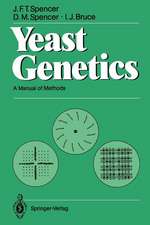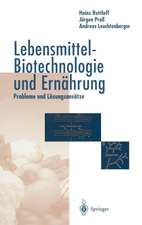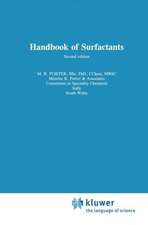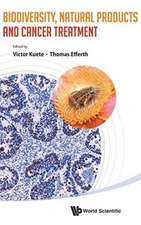Biodegradability of Surfactants
Editat de D. R. Karsa, M.R. Porteren Limba Engleză Hardback – 31 dec 1994
| Toate formatele și edițiile | Preț | Express |
|---|---|---|
| Paperback (1) | 1215.85 lei 6-8 săpt. | |
| SPRINGER NETHERLANDS – 21 sep 2012 | 1215.85 lei 6-8 săpt. | |
| Hardback (1) | 1220.88 lei 6-8 săpt. | |
| SPRINGER NETHERLANDS – 31 dec 1994 | 1220.88 lei 6-8 săpt. |
Preț: 1220.88 lei
Preț vechi: 1488.88 lei
-18% Nou
Puncte Express: 1831
Preț estimativ în valută:
233.62€ • 244.53$ • 194.44£
233.62€ • 244.53$ • 194.44£
Carte tipărită la comandă
Livrare economică 31 martie-14 aprilie
Preluare comenzi: 021 569.72.76
Specificații
ISBN-13: 9780751402063
ISBN-10: 0751402060
Pagini: 257
Ilustrații: XIII, 257 p.
Dimensiuni: 155 x 235 x 22 mm
Greutate: 0.54 kg
Ediția:1995
Editura: SPRINGER NETHERLANDS
Colecția Springer
Locul publicării:Dordrecht, Netherlands
ISBN-10: 0751402060
Pagini: 257
Ilustrații: XIII, 257 p.
Dimensiuni: 155 x 235 x 22 mm
Greutate: 0.54 kg
Ediția:1995
Editura: SPRINGER NETHERLANDS
Colecția Springer
Locul publicării:Dordrecht, Netherlands
Public țintă
ResearchCuprins
1 Introduction to surfactant biodegradation.- 1.1 Introduction.- 1.2 Biodegradability and the replacement of soap in detergent products.- 1.3 Biodegradation, biodegradability testing and interpretation of results.- 1.4 Sewage treatment processes and their significance for surfactants.- 1.5 Biodegradability test methods for surfactants.- 1.6 The replacement of tetrapropylene benzene sulphonate (TPBS).- 1.7 Surfactant biodegradability and legislation.- 1.8 Surfactant analysis.- 1.9 Conclusions and thoughts for the future.- References.- 2 What is biodegradation?.- 2.1 Setting the scene: Microbial nutrition and the carbon cycle.- 2.2 Surfactants as potential microbial nutrients.- 2.3 Surfactant biodegradation in the environment.- 2.4 Laboratory models of surfactant biodegradation.- References.- 3 Biodegradability testing.- 3.1 Introduction.- 3.2 Nature of biodegradation and influencing factors.- 3.3 OECD and EEC tests for primary biodegradability of surfactants.- 3.4 List and synopses of existing methods for ultimate biodegradability.- 3.5 Analytical methods.- References.- 4 Testing strategy and legal requirements.- 4.1 Selection of tests: strategy of testing.- 4.2 Validation and interpretation of results.- 4.3 Legal requirements.- References.- 5 Biodegradability of anionic surfactants.- 5.1 General characteristics of anionic surfactants.- 5.2 Application of anionic surfactants and their environmental relevance.- 5.3 Particular structure and application features of anionic surfactants.- 5.4 Biodegradation of anionic surfactants.- References.- 6 Biodegradability of cationic surfactants.- 6.1 Introduction.- 6.2 Biodegradability of cationic surfactants in OECD Screening tests.- 6.3 Behaviour of quaternary ammonium salts in waste water treatment plants.- 6.4 Biodegradation routes of quaternary ammonium salts.- References.- 7 Biodegradability of non-ionic surfactants.- 7.1 Introduction.- 7.2 Structure of polyglycol surfactants.- 7.3 General biodegradability.- 7.4 Mechanisms of biodegradation.- 7.5 Biodegradation of polyglycols.- Acknowledgements.- References.- 8 Biodegradability of amphoteric surfactants.- 8.1 Introduction.- 8.2 Structural elements and biodegradation in general.- 8.3 Alkyl betaines.- 8.4 Alkylamido betaines.- 8.5 Sulphobetaines and hydroxysulphobetaines.- 8.6 Alkylamphoacetates.- 8.7 Polycarboxyglycinates.- 8.8 Alkylamphopropionates.- 8.9 Imidazolinium betaines.- Acknowledgements.- References.
Recenzii
It is particularly useful..It is well printed, with few typographical errors. - Chemistry and Industry


